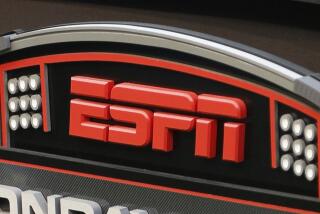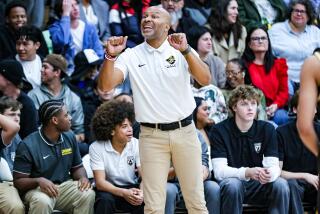Despite Criticism, Cable Network Channels Prep Sports Across Nation
- Share via
It’s the big game. From their Fountain Valley living room, Joe and Jane Sportsfan tune in the exciting high school football rivalry . . . between Mayfield and Tilghman Paducah high schools from Kentucky?
Despite the skeptics, SportsChannel America, a national cable network wired into 8.5-million homes, is pioneering the televising of regular-season high school sports to a national audience.
It is doing so amid criticism and speculation that televising regular-season games, especially football games, will lead to the kinds of abuse, rule-bending and corruption sometimes found at the college level. And it is doing so despite the fact assertions that previous attempts have failed financially.
SportsChannel executives insist their structure precludes any abuses and actually promotes and publicizes the virtues and rewards of high school athletics.
It’s that positive, almost public-service image that the cable network hopes to sell to advertisers to ensure the program’s success.
SportsChannel is a fledging enterprise currently reaching about one-tenth the audience that the major networks reach and about one-sixth the audience of ESPN--the nation’s leading all-sports network, said Dan Martinsen, a spokesman for the company.
Launched nationally in January, the cable network’s marquee product is the National Hockey League and Stanley Cup playoffs, to which it has exclusive cable rights. It also televises the Boston Marathon, some Notre Dame football and basketball games, professional boxing and national team baseball among other events.
The cable network has signed a five-year, $250,000-a-year agreement with the National Federation of State High School Associations to televise 14 high school football games. The cable network also will televise some boys’ and girls’ basketball games and possibly a few other sports.
It was the federation that approached SportsChannel a year ago with the idea of a package that would promote the positive values of high school athletics, said Jeff Ruhe, the cable network’s senior vice president and executive producer.
The two parties have structured a plan that both say has built-in safeguards against corruption.
Roy Englebrecht, a consultant to SportsChannel whose production company made Edison the first high school team in Southern California to have its games carried live on a commercial radio station, says there is not enough money in SportsChannel’s high school television package to induce participants to compromise their principles.
“In college you’re on TV if you win because the networks want to put winning programs on on Saturday afternoon,” he said. “The more you win, the more you get on TV and the more money you get. So colleges are kind of driven to win, and if they have their priorities wrong, they do whatever it takes to win (including) circumventing the rules--cheating.”
The high school federation has 17,500 member schools and no one school is going to appear more than once a season on SportsChannel, according to Warren Brown, the federation’s assistant executive director.
Brown estimates that a school will get approximately $1,200 for its appearance. “This is not money-driven on the part of the schools nor us,” he said.
According to Brown, after paying the cost of administering the program, paying the schools and the production of public service announcements on sportsmanship, drug education and the value of sports participation, the federation probably will lose money.
“I don’t see how anyone could arrive at the conclusion that high school sports is going to go to heck because of television,” Brown said.
SportsChannel executives say they will televise only existing rivalries and neither they nor the federation is in favor of creating a national championship or final four tournament at the high school level.
Though the federation is not money-driven, SportsChannel is. And company vice president Ruhe is confident that down the line, high school coverage can be profitable.
There is no question that television coverage of high school events on the local level has been popular with audiences. Profit is another matter.
Channel 4 televised “Prepsports World” in the early 1970s. The station broadcast football, basketball and state track and field championships, until increased network programming bumped it off the air, said George Paul, who produced and directed the show.
Anaheim-based Channel 56 televised Southern California-area football games in 1985 and ’86. The venture failed because of the saturation of Southland sports teams and the inability to attract and keep advertisers, said Chris Roberts, who did play-by-play for the games.
“Los Angeles is such a big sports market with all of our big pro sports teams that for the sports dollar, advertisers usually go to, if not to the Rams, Angels or Dodgers, they usually go on a secondary level,” Roberts said. “Let’s face it, if you have a budget and ‘X’ amount of dollars are for advertising, are you going to go for CIF football or USC?”
Other cable networks and stations have succeeded in televising high school sports nationally, but usually the coverage was of the television news magazine variety.
Prime Ticket airs “CIF High School Sports Beat” and USC and UCLA sports magazine shows. It will cover the Southern Section football championships, but focuses more on colleges.
For the past three years, ESPN has telecast the Texas 5-A football championships. This past Thanksgiving morning, ESPN aired a game between traditional rivals Phillipsburg, N.J. and Easton, Pa. The game had a Neilsen rating of 1.3. An average rating for that 10 a.m to 1 p.m. slot would be about 0.4., ESPN spokesman Rob Tobias said.
That’s a statistic that bodes well for SportsChannel.
ESPN also does a magazine-style show, “Scholastic Sports America.” The show is in its fourth year and focuses on “bigger events that will have broader national appeal,” said Steven Bornstein, executive vice president, programming and production.
ESPN went ahead with the show without strong sponsor support and subsequently achieved it, which is what SportsChannel hopes to do.
National high school coverage might be essential to SportsChannel’s survival. The cable network charges a subscriber a monthly fee for its service. Though it has the NHL and some other professional and collegiate sports, it still has to have programming to fill out the day.
“If I am a subscriber, why do I want to pay $10 a month if I am not going to get anything on there?” Englebrecht said.
SportsChannel is set up like a network with affiliates. It currently has offshoots in six regions: New York, New England, Florida, Chicago, Ohio and Los Angeles. Unlike a network, which provides most of a station’s programming, SportsChannel’s focus is on original, local programming with network programming rounding it out.
Two Los Angeles area schools, Banning and Carson, will play Nov. 9 in a game televised by SportsChannel. Eventually, SportsChannel subscribers would receive primarily high school games of interest in their area rather than a game from across the country.
SportsChannel is using this year to show regional advertisers that their programming is worthwhile, Ruhe said.
The test will be whether the cable network can attract a national sponsor. “We don’t have a national sponsor right now but I am confident we will within the next month,” Ruhe said.
More to Read
Go beyond the scoreboard
Get the latest on L.A.'s teams in the daily Sports Report newsletter.
You may occasionally receive promotional content from the Los Angeles Times.










